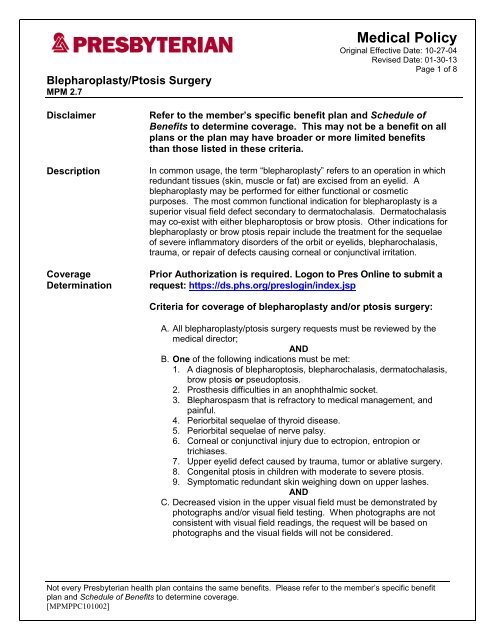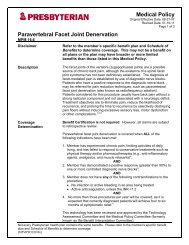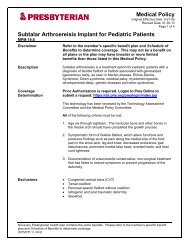Blepharoplasty/Ptosis Surgery, MPM 2.7 - Presbyterian Healthcare ...
Blepharoplasty/Ptosis Surgery, MPM 2.7 - Presbyterian Healthcare ...
Blepharoplasty/Ptosis Surgery, MPM 2.7 - Presbyterian Healthcare ...
You also want an ePaper? Increase the reach of your titles
YUMPU automatically turns print PDFs into web optimized ePapers that Google loves.
<strong>Blepharoplasty</strong>/<strong>Ptosis</strong> <strong>Surgery</strong><br />
<strong>MPM</strong> <strong>2.7</strong><br />
Medical Policy<br />
Original Effective Date: 10-27-04<br />
Revised Date: 01-30-13<br />
Page 1 of 8<br />
Disclaimer<br />
Description<br />
Coverage<br />
Determination<br />
Refer to the member’s specific benefit plan and Schedule of<br />
Benefits to determine coverage. This may not be a benefit on all<br />
plans or the plan may have broader or more limited benefits<br />
than those listed in these criteria.<br />
In common usage, the term “blepharoplasty” refers to an operation in which<br />
redundant tissues (skin, muscle or fat) are excised from an eyelid. A<br />
blepharoplasty may be performed for either functional or cosmetic<br />
purposes. The most common functional indication for blepharoplasty is a<br />
superior visual field defect secondary to dermatochalasis. Dermatochalasis<br />
may co-exist with either blepharoptosis or brow ptosis. Other indications for<br />
blepharoplasty or brow ptosis repair include the treatment for the sequelae<br />
of severe inflammatory disorders of the orbit or eyelids, blepharochalasis,<br />
trauma, or repair of defects causing corneal or conjunctival irritation.<br />
Prior Authorization is required. Logon to Pres Online to submit a<br />
request: https://ds.phs.org/preslogin/index.jsp<br />
Criteria for coverage of blepharoplasty and/or ptosis surgery:<br />
A. All blepharoplasty/ptosis surgery requests must be reviewed by the<br />
medical director;<br />
AND<br />
B. One of the following indications must be met:<br />
1. A diagnosis of blepharoptosis, blepharochalasis, dermatochalasis,<br />
brow ptosis or pseudoptosis.<br />
2. Prosthesis difficulties in an anophthalmic socket.<br />
3. Blepharospasm that is refractory to medical management, and<br />
painful.<br />
4. Periorbital sequelae of thyroid disease.<br />
5. Periorbital sequelae of nerve palsy.<br />
6. Corneal or conjunctival injury due to ectropion, entropion or<br />
trichiases.<br />
7. Upper eyelid defect caused by trauma, tumor or ablative surgery.<br />
8. Congenital ptosis in children with moderate to severe ptosis.<br />
9. Symptomatic redundant skin weighing down on upper lashes.<br />
AND<br />
C. Decreased vision in the upper visual field must be demonstrated by<br />
photographs and/or visual field testing. When photographs are not<br />
consistent with visual field readings, the request will be based on<br />
photographs and the visual fields will not be considered.<br />
Not every <strong>Presbyterian</strong> health plan contains the same benefits. Please refer to the member’s specific benefit<br />
plan and Schedule of Benefits to determine coverage.<br />
[<strong>MPM</strong>PPC101002]
<strong>Blepharoplasty</strong>/<strong>Ptosis</strong> <strong>Surgery</strong><br />
<strong>MPM</strong> <strong>2.7</strong><br />
Medical Policy<br />
Original Effective Date: 10-27-04<br />
Revised Date: 01-30-13<br />
Page 2 of 8<br />
The following criteria apply:<br />
1. PHOTOGRAPHS:<br />
• Eye photos are mandatory and must be submitted<br />
electronically (Health Services staff will contact requesting<br />
provider with an e-mail address). Photographs must be clear<br />
frontal views, in color, with the head perpendicular to the planes<br />
of the camera (not tilted) to demonstrate position of the true lid<br />
margin or the pseudo-lid margin.<br />
• The photos must be of sufficient clarity to show a light reflex on<br />
the cornea, indicating a fully or partially obstructed pupil.<br />
• If brow ptosis exists, or if redundant skin coexists with the<br />
true lid ptosis, additional photos must be taken with the upper<br />
lid skin retracted to show the actual position of the true lid<br />
margin (needed if both CPT codes 15822-15823 is required and<br />
planned in addition to 67900-67908).<br />
• Frontal oblique photos are needed to demonstrate redundant skin<br />
on the upper eyelashes when this is the only indication for surgery.<br />
• When both a blepharoplasty and a ptosis repair are planned,<br />
each condition must be individually documented. This may<br />
require two sets of photographs, which should demonstrate the<br />
effect of drooping of redundant skin (and its correction by<br />
taping) and the actual presence of blepharoptosis,<br />
blepharochalasis or dermatochalasis.<br />
• For brow ptosis repair, photos must show the natural eyebrow<br />
below the supraorbital rim. Two sets of photographs, one<br />
demonstrating correction by taping, are required.<br />
Not every <strong>Presbyterian</strong> health plan contains the same benefits. Please refer to the member’s specific benefit<br />
plan and Schedule of Benefits to determine coverage.<br />
[<strong>MPM</strong>PPC101002]<br />
AND<br />
2. VISUAL FIELDS:<br />
• Kinetic studies for visual field testing, preferably computerized,<br />
support photographic evidence of decreased vision in the upper<br />
visual field. An example of a computerized visual field<br />
analyzer is the Zeiss Humphrey Field Analyzer II. Visual field<br />
testing is not necessary in the following circumstances:<br />
o Patients with an anophthalmic socket experiencing difficulty<br />
with their prosthesis<br />
o Patients with blepharospasm that is refractory to medical<br />
management<br />
o Individuals who are unable to cooperate with the testing.
<strong>Blepharoplasty</strong>/<strong>Ptosis</strong> <strong>Surgery</strong><br />
<strong>MPM</strong> <strong>2.7</strong><br />
Medical Policy<br />
Original Effective Date: 10-27-04<br />
Revised Date: 01-30-13<br />
Page 3 of 8<br />
Documentation of the condition preventing cooperation is<br />
required.<br />
• Each eye should be tested using kinetic studies, with the upper<br />
eyelid at rest, and repeated with the lid elevated by taping of the<br />
lid to demonstrate potential correction by the proposed<br />
procedure(s). The visual field testing should document an<br />
improvement of at least 12° in the 90° meridian, utilizing the<br />
“predicted” and “measured” values of the “up” dimension.<br />
OR<br />
• The overall superior visual field is improved by 20% or more.<br />
The kinetic visual field analysis components of “predicted”<br />
(which refers to after taping, not “normal expected”) and<br />
“measured” will be utilized to calculate the percent improvement<br />
of the overall superior visual field. See attached worksheet<br />
for details on how visual analysis will be calculated.<br />
D. When one eyelid meets criteria, but the opposite eyelid does not,<br />
blepharoplasty of the opposite eyelid will be considered reconstructive<br />
if the following criteria are met:<br />
1. The opposite eye also exhibits abnormalities, as documented by<br />
photographs, and<br />
2. Visual field testing demonstrates that the visual field is improved at<br />
least 8° in the 90° meridian by mechanically raising/taping the<br />
eyelid.<br />
.<br />
E. Lower eyelid blepharoplasty may be medically necessary for the<br />
following indications. Photographic requirements, as stated in C1,<br />
continue to apply.<br />
1. Massive lower lid edema secondary to system corticosteroid<br />
therapy, myxedema, Grave’s disease, nephritic syndrome or other<br />
metabolic or inflammatory disorders.<br />
2. Entropion in which extra roll of pretarsal skin and orbicularis<br />
muscle deflects the eyelashes against the cornea.<br />
Exclusions<br />
Cosmetic surgery performed primarily to improve appearance and selfesteem<br />
is not a covered benefit.<br />
Not every <strong>Presbyterian</strong> health plan contains the same benefits. Please refer to the member’s specific benefit<br />
plan and Schedule of Benefits to determine coverage.<br />
[<strong>MPM</strong>PPC101002]
<strong>Blepharoplasty</strong>/<strong>Ptosis</strong> <strong>Surgery</strong><br />
<strong>MPM</strong> <strong>2.7</strong><br />
Medical Policy<br />
Original Effective Date: 10-27-04<br />
Revised Date: 01-30-13<br />
Page 4 of 8<br />
Medical Terms <strong>Blepharoplasty</strong>: Eyelid surgery to correct, repair or remove excess<br />
tissue. <strong>Blepharoplasty</strong> may improve abnormal<br />
function, reconstruct defects or enhance appearance.<br />
It can be either reconstructive or cosmetic. The goal<br />
of reconstructive surgery is to restore normal function<br />
to a structure that has been altered by trauma,<br />
infection, inflammation, degeneration, neoplasia or<br />
developmental errors.<br />
Blepharoptosis:<br />
Blepharochalasis:<br />
Brow <strong>Ptosis</strong>:<br />
Also known as “ptosis.” Drooping of an upper eyelid,<br />
due to paralysis. Causes of ptosis include a<br />
congenital developmental problem, aging, muscle<br />
diseases, nerve damage or trauma.<br />
Relaxation of the skin of the eyelid, due to atrophy of<br />
the intercellular tissue.<br />
Laxity of the forehead muscles which may result in<br />
functional visual impairment.<br />
Brow <strong>Ptosis</strong> Repair: Also known as brow lift. <strong>Surgery</strong> to lift the level of the<br />
brow, which contributes to the droop of the upper<br />
eyelids.<br />
Dermatochalasis:<br />
Ectropion:<br />
Entropion:<br />
Pseudoptosis:<br />
<strong>Ptosis</strong> Repair:<br />
Aging change of the eyelids, generally due to the<br />
effects of gravity, loss of elastic tissue and weakening<br />
of the connective tissues of the eyelid.<br />
The turning out of the eyelid (usually the lower eyelid)<br />
so that the inner surface is exposed, usually caused<br />
by the aging process and the weakening of the<br />
connective tissue of the eyelid.<br />
The turning in of the edges of the eyelid (usually the<br />
lower eyelid) so that the lashes rub against the eye<br />
surface. Entropion can be a congenital condition.<br />
“False ptosis” – the eyelid margin is usually in an<br />
appropriate position with respect to the eyeball and<br />
visual axis; however, the amount of excessive skin is<br />
so great it overhangs the eyelid margin and creates<br />
its own ptosis.<br />
Eyelid surgery to lift the level of the eyelid.<br />
The coding listed in this Medical Policy is for reference only. Covered and noncovered<br />
codes are included in this list. These CPT codes may potentially be<br />
considered as cosmetic and thus not covered unless requests are accompanied by<br />
appropriate documentation to support the indications noted above.<br />
Not every <strong>Presbyterian</strong> health plan contains the same benefits. Please refer to the member’s specific benefit<br />
plan and Schedule of Benefits to determine coverage.<br />
[<strong>MPM</strong>PPC101002]
<strong>Blepharoplasty</strong>/<strong>Ptosis</strong> <strong>Surgery</strong><br />
<strong>MPM</strong> <strong>2.7</strong><br />
Medical Policy<br />
Original Effective Date: 10-27-04<br />
Revised Date: 01-30-13<br />
Page 5 of 8<br />
CPT<br />
Codes<br />
Description<br />
15820 <strong>Blepharoplasty</strong>, lower eyelid<br />
15821 <strong>Blepharoplasty</strong>, lower eyelid with extensive herniated fat pad<br />
15822 <strong>Blepharoplasty</strong>, upper eyelid<br />
15823 <strong>Blepharoplasty</strong>, upper eyelid with excessive skin weighting down lid<br />
67900 Repair of brow ptosis (supraciliary, mid-forehead or coronal approach)<br />
67901 Repair of blepharoptosis; frontalis muscle technique with suture or other material<br />
67902 Repair of blepharoptosis; frontalis muscle technique with autologous fascial sling<br />
67903 Repair of blepharoptosis; (tarso) levator resection or advancement, internal approach<br />
67904 Repair of blepharoptosis; (tarso) levator resection or advancement, external approach<br />
67096 Repair of blepharoptosis; superior rectus technique with fascial sling<br />
67906 Repair of blepharoptosis; superior rectus technique with fascial sling (including obtaining<br />
fascia)<br />
67908 Repair of blepharoptosis; conjunctive-tarso-Muller’s muscle-levator resection<br />
67909 Reduction of overcorrection of ptosis<br />
ICD-9©<br />
Diagnosis<br />
Codes<br />
Description<br />
240.0 –<br />
242.91<br />
Goiter and thyrotoxicosis<br />
333.81 Blepharospasm<br />
351.0 –<br />
351.9<br />
368.00 –<br />
368.03<br />
368.40 –<br />
368.47<br />
373.30 –<br />
373.33<br />
Facial nerve disorders<br />
Amblyopia ex anopsia<br />
Visual field defects<br />
<strong>Ptosis</strong> of eyelid<br />
374.34 Blepharochalasis (pseudoptosis)<br />
374.87 Dermatochalasis<br />
374.89 Other disorders of eyelid<br />
Not every <strong>Presbyterian</strong> health plan contains the same benefits. Please refer to the member’s specific benefit<br />
plan and Schedule of Benefits to determine coverage.<br />
[<strong>MPM</strong>PPC101002]
<strong>Blepharoplasty</strong>/<strong>Ptosis</strong> <strong>Surgery</strong><br />
<strong>MPM</strong> <strong>2.7</strong><br />
Medical Policy<br />
Original Effective Date: 10-27-04<br />
Revised Date: 01-30-13<br />
Page 6 of 8<br />
ICD-9©<br />
Diagnosis<br />
Codes<br />
Description<br />
743.00 Clinical anophthalmos, unspecified<br />
743.61 Congenital ptosis of eyelids<br />
743.63 Other specified congenital anomalies of eyelid<br />
996.69 Infection, inflammatory reaction due to other internal prosthetic device (prosthetic<br />
orbital implant)<br />
V45.78 Acquired absence of eye<br />
Reviewed by: 1. Thomas Carlow, MD, Eye Associates of New Mexico, September, 2004,<br />
November 2005<br />
2. Dennis Sandoval, MD, Eye Facial <strong>Surgery</strong> of New Mexico, PC, September<br />
2004, November 2005, July 2006, September 2007<br />
3. Richard Allen, MD, Eye Associates of New Mexico, October 2007<br />
4. Randolph E. Black, MD, Southwest Eye Care Specialists. October 2009.<br />
References:<br />
1. Centers for Medicare and Medicaid Services. Trailblazer Health Enterprises,<br />
LLC. Local Coverage Determination L26827: <strong>Blepharoplasty</strong>. Effective Date:<br />
3-01-08. Accessed on the Internet 09-14-2010: Accessed 1-4-11. Revised billing<br />
instructions. No other changes.<br />
http://www.trailblazerhealth.com/Tools/Local%20Coverage%20Determinations/Def<br />
ault.aspxID=2947&DomainID=1 <strong>Blepharoplasty</strong> L26827. Revised 7-01-11. Billing<br />
instructions.<br />
2. Centers for Medicare and Medicaid Services. Novitas Solutions Inc. LCD<br />
L32715. <strong>Blepharoplasty</strong>. Accessed on the internet 1-22-13. Revised original<br />
effective date 11-19-12 and add Novitas Jurisdiction for Colorado, New Mexico,<br />
Oklahoma, Texas, Indian Health Services, and VA Veterans Affairs. No other<br />
changes.<br />
3. Medicare Part B Local Coverage Determination, Oklahoma/New Mexico Plastic<br />
<strong>Surgery</strong> Procedures of the Eye, February 15, 2005<br />
4. Milliman Care Guidelines, Ambulatory Care, 13th Edition, 2009. <strong>Blepharoplasty</strong>,<br />
Canthoplasty, or Related Procedure (Eye Conditions). Last update: 02-05-09.<br />
Accessed 11-4-11. Last updated 9-19-11. No change. Accessed 1-22-13. ACG:<br />
A-0195 Last updated 8-28-12. No change.<br />
5. American Society of Plastic and Reconstructive Surgeons, Position Paper,<br />
<strong>Blepharoplasty</strong>, Recommended Criteria for Third-Party Payer Coverage, March 2007<br />
6. American Academy of Ophthalmology, Functional Indications for Upper and<br />
Lower Eyelid <strong>Blepharoplasty</strong>, Ophthalmic Technology Assessment, 1995<br />
7. Emedicine from WebMD, <strong>Blepharoplasty</strong>, Upper Lid <strong>Ptosis</strong> <strong>Surgery</strong>, June 26,<br />
2005. Article last updated 01-30-08. Accessed on the Internet 10-29-09:<br />
Not every <strong>Presbyterian</strong> health plan contains the same benefits. Please refer to the member’s specific benefit<br />
plan and Schedule of Benefits to determine coverage.<br />
[<strong>MPM</strong>PPC101002]
<strong>Blepharoplasty</strong>/<strong>Ptosis</strong> <strong>Surgery</strong><br />
<strong>MPM</strong> <strong>2.7</strong><br />
Medical Policy<br />
Original Effective Date: 10-27-04<br />
Revised Date: 01-30-13<br />
Page 7 of 8<br />
http://www.emedicine.com/ Accessed 1-22-13.<br />
8. Erb, Melanie H. MD, et al, Effect of Unilateral Blepharoptosis Repair on<br />
Contralateral Eyelid Position. Ophthal Plast Reconstr Surg, Vol. 20, No. 6, 2004.<br />
Approval<br />
Signatures:<br />
Clinical Quality Committee:<br />
Mark Whitaker MD<br />
Medical Director:<br />
Albert Rizzoli MD<br />
Approval<br />
Date: January 30, 2013<br />
Publication<br />
History<br />
PHP Internal Criteria <strong>2.7</strong>:<br />
Effective Date: October 27, 2004<br />
Review Date: July 2006, August-October 2007, October 2008<br />
Revision Date: November 2005, July 2006, October 2007, October 2008,<br />
September 2010<br />
10-22-08: Transitioned to Medical Policy, Annual review and revision<br />
10-28-09: Annual review and revision<br />
09-22-10: Annual review and revision<br />
01-18-12 Annual Review and revision<br />
01-30-13: Annual Review and Revision<br />
This Medical Policy is intended to represent clinical guidelines describing medical appropriateness and is<br />
developed to assist <strong>Presbyterian</strong> Health Plan and <strong>Presbyterian</strong> Insurance Company, Inc. (<strong>Presbyterian</strong>) Health<br />
Services staff and <strong>Presbyterian</strong> medical directors in determination of coverage. The Medical Policy is not a<br />
treatment guide and should not be used as such.<br />
For those instances where a member does not meet criteria guidelines, additional information supporting medical<br />
necessity is welcome and medical directors may use them in reviewing the case. Please note that all <strong>Presbyterian</strong><br />
Medical Policies are available on the Internet at:<br />
http://www.phs.org/phs/healthplans/providers/healthservices/Medical/index.htm<br />
Not every <strong>Presbyterian</strong> health plan contains the same benefits. Please refer to the member’s specific benefit<br />
plan and Schedule of Benefits to determine coverage.<br />
[<strong>MPM</strong>PPC101002]
<strong>Blepharoplasty</strong>/<strong>Ptosis</strong> <strong>Surgery</strong><br />
<strong>MPM</strong> <strong>2.7</strong><br />
Medical Policy<br />
Original Effective Date: 10-27-04<br />
Revised Date: 01-30-13<br />
Page 8 of 8<br />
Member Name and/or Number<br />
Kinetic Visual Field Analysis for <strong>Blepharoplasty</strong><br />
Worksheet for PHP Health Services<br />
RIGHT EYE<br />
Normal<br />
Expected Measured Predicted Difference<br />
Temp 85°<br />
UpTemp 55°<br />
Up 45°<br />
UpNasal 55°<br />
Nasal 60°<br />
Potential 300°<br />
LEFT EYE<br />
Normal<br />
Expected Measured Predicted Difference<br />
Temp 85°<br />
UpTemp 55°<br />
Up 45°<br />
UpNasal 55°<br />
Nasal 60°<br />
Potential 300°<br />
The “measured” values indicate the eyelid at rest. The “predicted” values indicate the eyelid taped.<br />
To calculate the degree of improvement anticipated after blepharoplasty:<br />
• Utilize the “Up” row.<br />
• Subtract the “measured” degrees from the “predicted” degrees – the “difference” is how much the<br />
visual field will improve with blepharoplasty.<br />
To meet PHP criteria, improvement must be 12° or more.<br />
If improvement is not 12° or more, then calculate the percentage of the overall superior visual field<br />
improvement.<br />
To calculate the percentage of the overall superior visual field improvement:<br />
• Utilize “Potential”, which is the sum of Temp, Up Temp, Up, Up Nasal and Nasal<br />
• Subtract the “measured” degree from the “predicted” degree, to calculate the “difference.” This<br />
gives the degree of improvement.<br />
• Divide the degree of improvement by the “measured” degree.<br />
• This number will give you a percent improvement of the overall superior visual field.<br />
• Here’s an equation stating the same process:<br />
“Predicted” minus “measured” = degree of improvement<br />
Degree of improvement divided by “measured” = % improvement of superior visual field<br />
TO MEET PHP criteria, the percent of overall superior visual field improvement must be 20% or greater.<br />
Not every <strong>Presbyterian</strong> health plan contains the same benefits. Please refer to the member’s specific benefit<br />
plan and Schedule of Benefits to determine coverage.<br />
[<strong>MPM</strong>PPC101002]

















